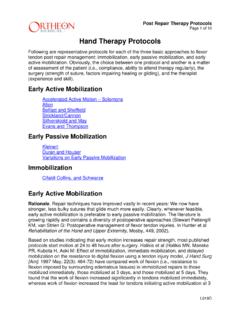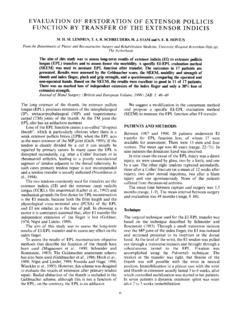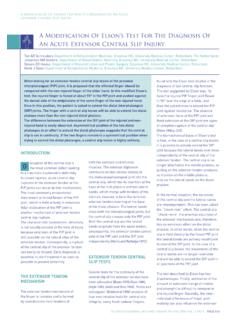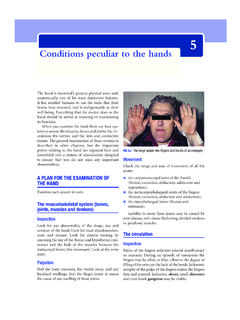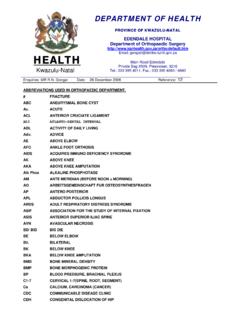Transcription of The Intrinsic Muscles of the Hand Function, …
1 20 Wissenschaft und Forschung The Intrinsic Muscles of the hand function , Assessment and Principles for Therapeutic Intervention Tiefe Handmuskulatur Funktion, Assessment und Grundlagen der therapeutischen Intervention Authors T. A. R. Schreuders1, J. W. Brandsma3, H. J. Stam2. 1. Af liations Erasmus MC University Medical Center Rotterdam, Department of Rehabilitation Medicine, Rotterdam, The Netherlands 2. Green Pastures Hospital, Pokhara, Nepal 3. ALERT Training Division, Addis Ababa, Ethiopia Key words Abstract Zusammenfassung hand Muscles & &. muscular function This article reviews the functional anatomy of Die Arbeit bietet einen berblick ber die assessment the Intrinsic Muscles of the ngers (palmar inter- Anatomie der tiefen Handmuskel (Mm. interos- anatomy ossei, dorsal interossei, hypothenar and lumbri- sei palmares et dorsales, Hypothenar- und rehabilitation cal Muscles ) and discusses the pathokinesiology Lumbrikalmuskel) und diskutiert die pathologische Schl sselw rter of the hand with Intrinsic muscle paralysis and Kinesiologie der Hand mit Parese der tiefen Handmuskel its consequences for Activities for Daily Living.
2 Muskulatur und die Konsequenzen f r die Aktivi- Muskelfunktion The assessment of muscle strength: manual t ten des t glichen Lebens. Dar ber hinaus Assessment and instrumental and principles for therapeutic werden manuelle und apparative Methoden Anatomie intervention are also discussed. der Handkraftmessung diskutiert sowie thera- Rehabilitation peutische Prinzipien bei Verletzungen der tiefen Handmuskulatur er rtert. Introduction Although assessment of muscle strength and & length are important elements of hand examina- Many valuable studies have been published tion other functions , such as mobility, sensibility about the anatomy [1 5], mechanics [6 10], and and central properties of the brain, are equally or architectural design [11], of the Intrinsic Muscles even more important for hand function.
3 Co-ordi- of the hand. Understanding the mechanics of nation and speed of hand movements are dif - human dexterity requires an appreciation of the cult to assess and quantify but nevertheless eingegangen: 4. Oktober 2005 kinetic chains that comprise the hand, and the important features of Muscles , which control angenommen: intricate interplay of Muscles and ligaments that hand function. 18. Mai 2006 control its movements. In these chains, the Hand function tests have been developed by Intrinsic Muscles of the hand are of paramount Moberg [15], Bendz [16], Sollerman et al. [17], Bibliography importance for ef cient hand function [11]. and Light et al. [18]. Most of these tests would DOI There is a considerable decrease in functional record the time it takes to nish a set of activities.
4 Phys Med Rehab Kuror 2007; ef ciency in hands with loss of Intrinsic muscle Clinicians often observe that patients with 17: 20 27. function, often referred to as the claw hand or impairments of the hand quickly learn to com- Georg Thieme Verlag KG. Stuttgart New York Intrinsic minus hand ( Fig. 1) [12 14]. pensate for lost functions . Therefore, tests for ISSN 0940-6689 A comprehensive analysis of hand function hand function may only assess the ability of the should include assessment of the strength and patient to compensate for lost function. Correspondence length of the Intrinsic Muscles . This will provide There is little consensus about classi cations of Dr. med. T. A. R. Schreuders important information and assist the assessor in prehensile patterns of hand function [19].
5 The Erasmus MC - University determining nerve function, deciding which general characteristics remain largely consistent Medical Center Rotterdam . muscle group(s) may need to be strengthened, if with the following categories: pinch grips (tip Department of Rehabilitation . and what splint maybe needed and what surgery pinch, lateral or key pinch, and tripod or chuck Medicine Room H014 Dr. Molewaterplein 40 3015 GD needs to be considered nerve graft, tendon pinch) and three modes of gripping: (power grip, Rotterdam, The Netherlands transfer, or if conservative management is still spherical or exion grip, and extension grip in Tel.: + 31/10/463 28 67 indicated. Intrinsic plus position) [18]. It is estimated that Fax: + 31/10/463 38 43 for a full range of naturally common grips, a Schreuders TAR et al.
6 The Intrinsic Muscles Phys Med Rehab Kuror 2007; 17: 20 27. Wissenschaft und Forschung 21. Type I most proximal, attached to: tubercle of proximal phalanx, transverse and oblique bres of extensor apparatus the volar plate. Type II is like type 1 except that there is no attachment to the bone (a) and part of the insertion is into: the lateral band. Type III has all four attachments a, b, c and d. The rst dorsal interosseous (1 DI) insertion is of type I. All other DI are of type III. All PI have a type II insertion, but variations are possible [22]. Because of its insertion, the strongest activity of the 1 DI is in key pinch when the thumb is pressed against the mid-phalanx of the index nger. The 1 DI is also active in tip pinch, when the tip of the thumb is pressed against the tip of the Fig.
7 1 Long-standing paralyses of all Intrinsic Muscles can cause severe index nger. In that case the main action is as a exor at the clawing of the ngers. metacarpophalangeal (MCP) joint. The rst palmar interosseous (1 PI) muscle is more active in tip pinch activities and produces some supination of the index nger to get good approximation spherical grip is required for 10 %, a tripod grip for 10 %, a power with the pulp of the thumb. In this respect we might consider grip for 25 %, a lateral grip for 20 %, a tip grip for 20 %, and an the 1 PI as the opponens indices muscle. extension grip for 10 % of activities of daily living. Without The insertion into the lateral band of the extensor apparatus (d). Intrinsic Muscles a power grip is somewhat weaker but still pos- is important for extension at the proximal interphalangeal (PIP).
8 Sible. For all grips the Intrinsic Muscles play an important role. joints. The aim of this paper is fourfold: Without interosseous the nger is unstable and will collapse to review the functional anatomy of the Intrinsic Muscles of into the claw ( Intrinsic minus) position of (hyper) exten- the ngers. sion of the MCP joint and exion of the IP joints when loaded. to discuss the pathokinesiology of the hand with Intrinsic Therefore the interosseous (or interossei) Muscles are some- muscle paralysis, its consequences for Activities for Daily Liv- times referred to as the anti-claw Muscles [13]. The primary ing (ADL) and muscle shortening. function of the interosseous (see above) is MCP exion/. to present possibilities for the assessment of muscle strength: stabilisation with extension of the interphalangeal (IP) joints.
9 Manual and instrumental. This is especially evident during pinch in which the collapse of to discuss principles for therapeutic intervention: prevention the index PIP joint is apparent and results in hyper exion, of complications and strengthening exercises. often > 90 . This is a sign of interosseous muscle weakness and is The hypothenar Muscles will be discussed as a separate group sometimes referred to as the Mannerfelt sign [23] ( Fig. 2). and the Intrinsic Muscles of the thumb will be discussed in a Recording the moments of the Intrinsic Muscles that were gen- companion paper. erated after electrical stimulation, Lauer et al. [9] found that the For this paper the authors have selected studies mainly from dorsal interosseous Muscles were strong abductors of the n- rehabilitation, hand surgery, hand therapy and biomechanical gers and that they also generated a signi cant moment in MCP.
10 Journals. joint exion and IP joint extension. Similarly, Ketchum et al. [12]. found that the interosseous muscle of the index nger contrib- utes 73 % to the overall moment for exion of the MCP joint. Li et Intrinsic Muscles of the ngers al. [10] investigated the role of the interosseous Muscles during & nger exion tasks. When an external-volar force is applied In general, each nger has six Muscles controlling its move- proximally to the PIP joint, the extensor mechanism ( Intrinsic ments: three extrinsic Muscles (two long exors and one long muscle group) contributes the largest (70 %) force (of all exors). extensor) and three Intrinsic Muscles (dorsal and palmar inter- osseous and lumbrical Muscles ). The little nger and the index nger each have an additional extrinsic extensor.
